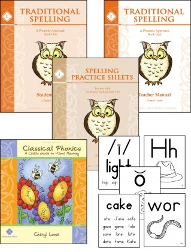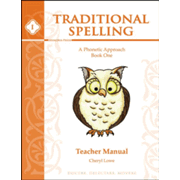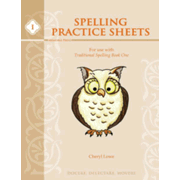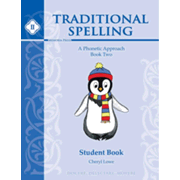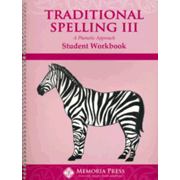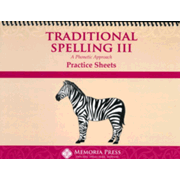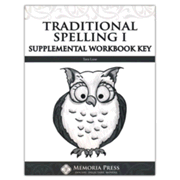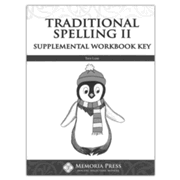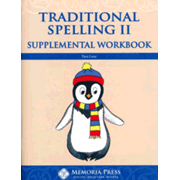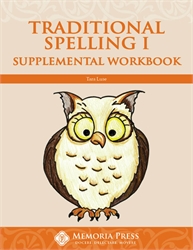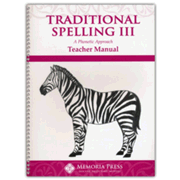Traditional Spelling I through V can be used as stand-alone spelling courses, and they also serve as the final pieces of the Memoria Press phonics program. Traditional Spelling I was written for use by students who have completed Memoria's kindergarten program which includes Classical Phonics and the First Start Reading Books A through D. Because of its strong phonics base, the Traditional Spelling series can also be used by students who have learned (or are learning) phonics in some other fashion. Before starting Traditional Spelling I, students must be able to read both short- and long-vowel words as well as basic sight words.
Traditional Spelling I teaches ten spelling words each week. While the first lesson begins with short-vowel words, the second lesson teaches words that include various phonograms that make the long a sound. Two-syllable words are introduced in the ninth lesson and contractions in Lesson 21. Students start to identify the syllables within words during the last third of the course. By the end of the book, students are spelling words such as weather, knife, and season. Because it covers so much territory, you might use the first course in either first or second grade.
Traditional Spelling II teaches 15 spelling words each week, beginning with words that include paired-consonant phonograms such as thanks, pick, and cuff. Students learn about homonyms such as dear and deer or hole and whole. Toward the end of the course, they are spelling words such as enjoyment, ceiling, neither, and author. This course is best used with second or third graders.
Traditional Spelling III jumps to 20 spelling words per week, and it begins the first lesson with words such as frosty, selfless, wept, and glove. Students will go on to learn challenging spelling words such as weasel, fungi, larvae, and intercept.
Traditional Spelling IV introduces 20 spelling words each week, teaching many challenging words such as those containing eigh, au, and aught. Word-study activities led by the teacher help students analyze words to learn correct spellings. For example, students learn about open and closed syllables and spelling rules that rely on the proper identification of syllables. Vocabulary instruction gets more attention, and students work with Latin word roots.
Specific Classical Phonics lesson pages and flashcards are referenced throughout the first two Traditional Spelling teacher manuals and are used for the first day’s lesson presentation each week. Because they are used so frequently, customers need to purchase Classical Phonics and the flashcards along with those two courses if they don't already own them.
The Traditional Spelling courses reinforce phonics while teaching spelling words that are grouped by phonetic concepts. The courses also teach spelling and syllabication rules. A Phonics Overview for the Teacher at the back of each teacher manual covers the basic consonant and vowel sounds plus all of the other phonograms, such as ph, oi, squ, and ough. Here you will also find seven phonics rules, seven spelling rules, and five syllabication rules. Parents and teachers might find this information extremely helpful. Those using Traditional Spelling III might need to rely on the Phonics Overview for assistance with phonetic concepts since that course doesn't use Classical Phonics or the flashcards. The various rules and explanations of phonetic concepts are taught or reviewed in just about every lesson.
All courses present 34 weekly spelling lessons following the same basic format for lessons five days each week, but with reinforcement activities that vary. The second and third courses add cursive models for students who have learned cursive or are making the transition that year. The courses increase in difficulty fairly significantly each year.
The courses are truly traditional. While modern spelling programs often include scrambled words for children to decipher and boxes to fit the shapes of the letters. Traditional Spelling uses time-tested methods. Children are taught the correct spelling from the beginning with no guessing on a pre-test. Phonograms and phonics rules are explicitly taught and used. Students use colored pencils to identify vowels, consonants, and lengthier phonograms as well as silent letters. Words are taught with definitions and in the context of sentences and a short story. Oral dictation is used once students have had time to learn the spelling words. Students also take complete sentences from dictation.
However, some of the teacher-directed activities (often presented on the second and third days of the week) use more novel methods of learning along with occasional games. They include activities such as putting words into word families, playing a concentration game to match syllables of words, and making up riddles about the spelling words for others to guess. Many of the activities rely on having two or more students, so some of them won't be usable for students working alone. There are also two pages in the appendices of each teacher manual with a list of games to play under the headings "Individual Games" and "Group Games." The group games offer fun activities, but the individual games just offer learning methods for different learning modalities, such as cutting letters from magazines to create the spelling words, using Scrabble® tiles to spell words, and outlining spelling words with different colors of crayons.
Lessons are designed to be presented by the teacher or parent with many of the lesson activities shown only in the teacher manuals. Even though teacher manuals provide detailed lesson plans for each day, I think that some homeschoolers might skip part of the direct instruction if it seems unnecessary. For example, you might not discuss definitions of the spelling words if your child already knows them. It's important to note that Memoria Press has instructional videos available for all these spelling courses that some will find helpful.
In the student books, four pages for each lesson provide written exercises. You can also use the books titled Spelling Practice Sheets that are available for the first three courses. These books have each week’s spelling words on the left of a page with either two or three columns to the right of the words. The other columns provide lines for practicing writing each word.
The first two courses also have an optional Supplemental Workbook, and these have their own answer key books. These workbooks have two pages for each lesson. They might be particularly useful to homeschooling parents who don't find many of the teacher-directed activities in the teacher manual practical for their situation. While the primary lessons need to be taught, the Supplemental Workbooks can usually be completed by students working independently.
Summary
Traditional Spelling was designed for classroom situations, and this is reflected in the instructions. However, the courses should work well in homeschool situations. Traditional Spelling’s strong reinforcement of phonics and the method of grouping spelling words around phonetic concepts helps students learn to think about spelling from that perspective rather than encouraging simple memorization. Taken together, the methods encourage critical thinking and analysis when it comes to spelling, tools that should serve students well for their entire lives.

